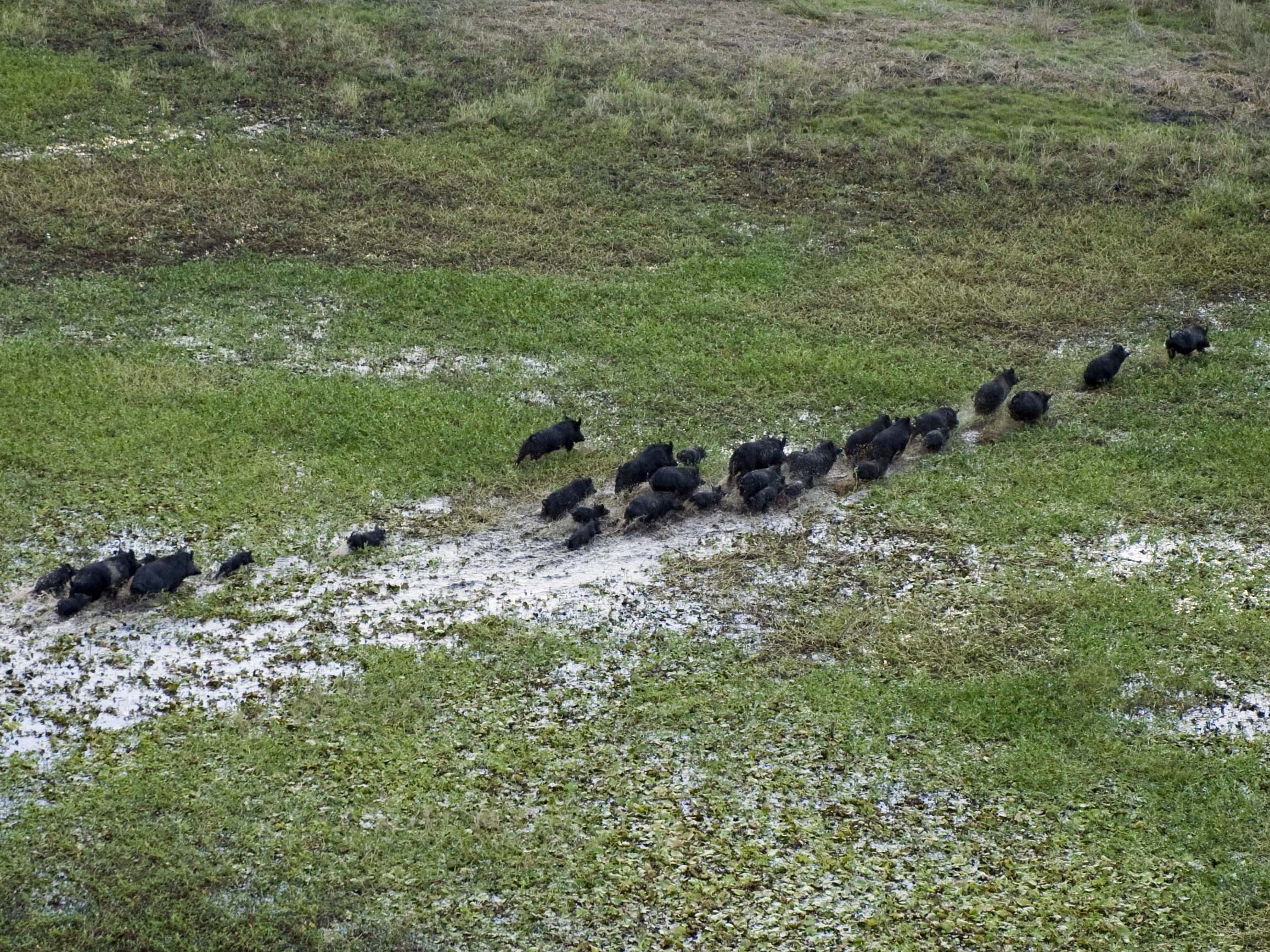Quick facts
- Despite the high mortality
- of piglets and juveniles, high fertility means that feral pigs can rapidly increase their population each year[2][4].
Feral pigs require access to water, food, and cover and these requirements are highly predictive of their distribution and abundance. Because they require readily available access to water, they are typically associated with wetlands and waterways and not usually found in the dry interior of the country[5]. In locations where resources are readily available, feral pigs may form permanent populations. Feral pigs will relocate when food opportunities are low and their demanding energy requirements are not being met[4].
Feral pigs live in matrilineal groups known as “sounders” or “mobs” that are comprised of female pigs, their offspring, sexually immature juveniles, and other female related sows (e.g. aunts, sisters, etc.)[8]. Sounders are generally territorial but can have overlapping home ranges with other sounder groups[8]. Sounders of females, piglets, and juveniles tend to have smaller home ranges than solitary boars[3].
Feral pigs:
- are omnivorous and opportunistic and ingest a variety of vegetation, fruit, grains, fungi, and animal components, including terrestrial and aquatic invertebrates (e.g. frogs and crustaceans), vertebrates (e.g. turtles and lizards) and their eggs[2][7][6][1]
- are most active between late afternoon and early morning[3]
- lack sweat glands, so they require access to shade and water to regulate their temperature
- generally live for less than five years, making them a relatively short-lived species[5][2][4]
- are highly fertile - sows (female pigs) can reproduce during their first year of life[2], breed throughout the year (under the right conditions) and can produce two litters a year of up to six piglets[2][4].
References
- ^ Australian Government (2017), Threat abatement plan for predation, habitat degradation, competition and disease transmission by feral pigs (Sus scrofa). [online], Commonwealth of Australia. Available at: https://www.environment.gov.au/system/files/resources/b022ba00-ceb9-4d0b-9b9a-54f9700e7ec9/files/tap-feral-pigs-2017-background-document.pdf.
- ^ a b c d e f Australian Pork Limited (2020), Australian Feral Pig Report - July 2020. [online], National Feral Pig Action Plan. Available at: https://feralpigs.com.au/wp-content/uploads/2020/07/National-Feral-Pig-Management-APL-Report-July-2020.pdf.
- ^ a b Centre for Invasive Species Solutions (2011), 'Feral pig biology, ecology and behaviour. Factsheet', PestSmart website. [online] Available at: https://pestsmart.org.au/toolkit-resource/feral-pig-biology-ecology-and-behaviour/.
- ^ a b c d e Department of Primary Industries and Fisheries (2008), Feral pig : A practical guide to pig control in Queensland, Queensland.
- ^ a b c Department of Sustainability, Environment, Water, Population and Communities (2011), THE FERAL PIG (SUS SCROFA). [online], Department of Sustainability, Environment, Water, Population and Communities, Canberra ACT. Available at: https://www.environment.gov.au/system/files/resources/a897fd1d-3d5c-408d-957e-3cf03f0b103b/files/pig.pdf.
- ^ Marshall, JC, Blessing, JJ, Clifford, SE, Negus, PM & Steward, AL (2020), 'Epigeic invertebrates of pig‐damaged, exposed wetland sediments are rooted: An ecological response to feral pigs ( <span style="font-variant:small-caps;"> <i>Sus scrofa</i> </span> )', Aquatic Conservation: Marine and Freshwater Ecosystems. [online], vol. 30, no. 12, pp. 2207-2220. Available at: https://onlinelibrary.wiley.com/doi/10.1002/aqc.3468 [Accessed 12 August 2021].
- ^ Mitchell, J, Experimental Research to Quantify the Environmental Impact of Feral Pigs within Tropical Freshwater Ecosystems. [online], Department of Environment, Water, Heritage and the Arts, Canberra. Available at: https://www.awe.gov.au/sites/default/files/documents/feral-pigs-impacts.pdf.
- ^ a b Wehr, NH, Hess, SC & Litton, CM (April 2018), 'Biology and Impacts of Pacific Islands Invasive Species. 14. <i>Sus scrofa,</i> the Feral Pig (Artiodactyla: Suidae) <sup/>', Pacific Science. [online], vol. 72, no. 2, pp. 177-198. Available at: http://www.bioone.org/doi/10.2984/72.2.1 [Accessed 9 December 2021].
Last updated: 10 May 2021
This page should be cited as:
Department of Environment, Science and Innovation, Queensland (2021) Feral pigs, WetlandInfo website, accessed 8 May 2025. Available at: https://wetlandinfo.des.qld.gov.au/wetlands/ecology/components/biota/fauna/fauna-pests/feral-pigs.html

 — Department of the Environment, Tourism, Science and Innovation
— Department of the Environment, Tourism, Science and Innovation


